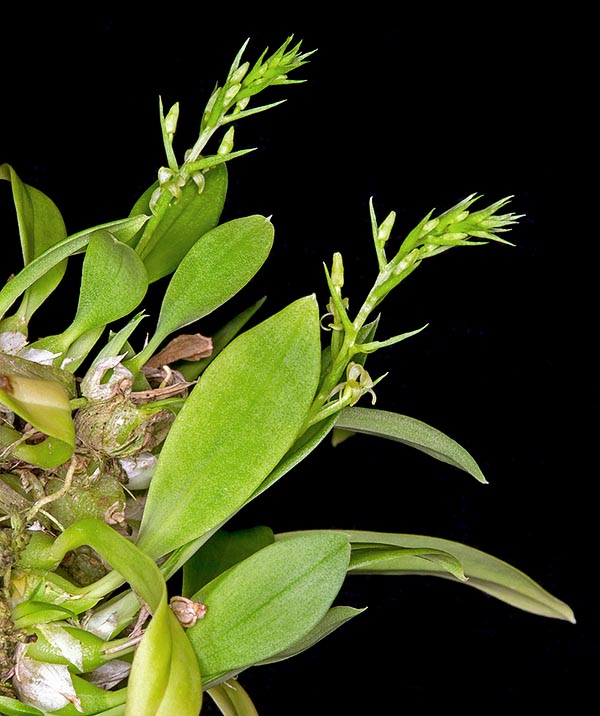Family : Orchidaceae

Text © Pietro Puccio

English translation by Mario Beltramini

We canot certainly say that Liparia cespitosa is a beautiful plant, but she has colonized most of the tropical world from eastern Africa to Oceania, from the sea level up to around 1500 m of altitude © Giuseppe Mazza
The species is native to a vast area that goes from eastern Africa to Oceania: Tanzania, Uganda, Malawi, Mozambique, Madagascar, Réunion, Mauritius, India, Sri Lanka, Himalaya, Myanmar, Thailand, Cambodia, Laos, Malaysia, Vietnam, China (Yunnan), Taiwan, Sumatra, Java, Borneo, Sulawesi, Moluccas, Philippines, New Guinea, Japan, Solomon Islands, New Caledonia, Vanuatu, Fiji and Samoa where it grows usually on the lowest branches of the trees of the humid evergreen forests, from the sea level up to about 1500 m of altitude.
The name of the genus comes from the Greek adjective “λιπαρός” (liparόs) = glossy, oily, with reference to the glossy leaves of many species; the specific name is the Latin adjective “caespitosus, a, um “ = cespitose, with obvious reference.
Common names: clumping liparis (English); tai dê (Vietnamese).
The Liparis cespitosa (Lam.) Lindl. (1825) (1825) is an epiphytic species with close ovate-piriform pseudobulbs on a creeping rhizome, 1-2 cm long, with at the apex only one leaf oblong-spatulate with pointed apex, 4-15 cm long and 0,6-1,8 cm broad, of pale green colour and glossy, coriaceous.
Racemose terminal inflorescences, erect, 10-22 cm long, bearing 10-40 yellowish green flowers, of about 8 mm of diameter, that gradually open. Linear floral bracts with pointed apex, about 8 mm long, oblong-lanceolate sepals, 2-3 mm long and 1 mm broad, linear petals 2-3 mm long and 0,5 mm broad, oblong-rectangular curved labellum, 2-3 mm long and 1-2 mm broad, and arcuate 1-2 mm long column.
It has been noted that the plants living at high altitudes and in particularly humid and rainy areas usually present the phenomenon of the cleistogamy, with self-pollinating flowers that open for few days or do not open at all, those at low altitudes and in drier climates are, on the contrary, self-incompatible and open regularly. The fruits are subglobose 6-8 mm long capsules.
It reproduces by seed, in vitro, and by division, with each section provided of at least 3-4 pseudobulbs.
Vigourous species forming dense tufts, requires a shady position and tolerates an ample range of temperatures, from 5 °C to 36 °C, even if are to be preferred intermediate temperatures, high humidity, 65-80%, and constant ventilation.

Vigourous epiphyte, bears relatively low temperatures with 10-22 cm inflorescences and microscopic flowers that in harsh environments can also self-fecundate © Giuseppe Mazza
Regular and abundant waterings during the growth, but allowing the substratum to slightly dry up before giving water again, more spaced in winter, but without ever letting it completely dry, utilizing rain water, demineralized or by reverse osmosis. It is usually mounted on trunks, pieces of bark or rafts of cork or of roots of arborescent ferns; eventual transplants are to be done at the vegetative restart.
The species is reported in the appendix II of CITES (species whose trade is internationally ruled).
Synonhyms: Epidendrum cespitosum Lam. (1783); Malaxis angustifolia Blume (1825); Liparis angustifolia (Blume) Lindl. (1830); Liparis auriculata Rchb. f. (1872); Liparis pusilla Ridl (1886); Leptorchis caespitosa (Thouars) Kuntze (1891); Liparis comosa Ridl. (1896); Cestichis caespitosa (Thouars) Ames (1908).
→ For general notions about ORCHIDACEAE please click here.
